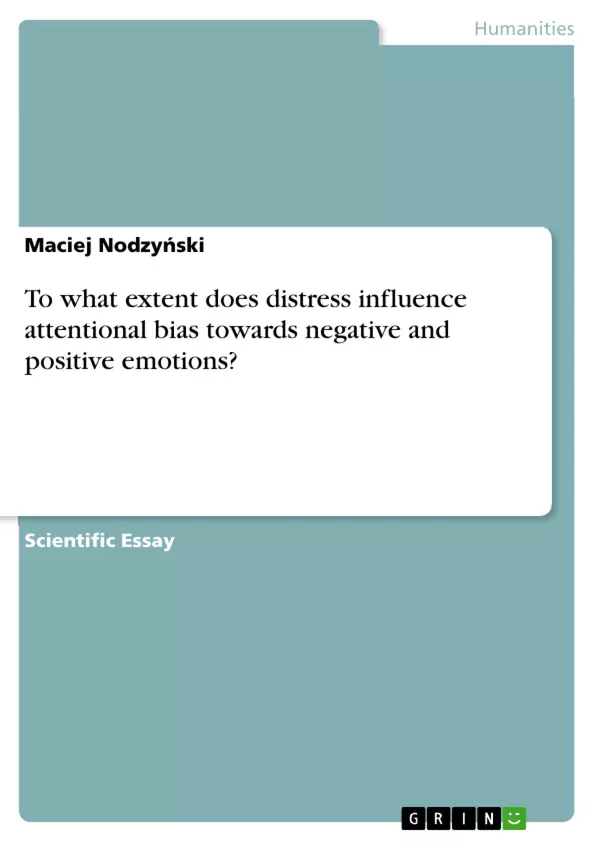To what extent does distress influence attentional bias towards negative and positive emotions? This paper is divided into two main sections. The first part talks about the attentional bias under conditions of distress towards negative emotion, whereas the second one towards positive emotion. Every part consists of pieces of literature that confront each other so the research is more objective and transparent. Besides that, general theory as well as key terms are explained. The paper concludes that there is a considerable impact of distress on attentional bias, especially towards negative emotional material, however, more research into the concept of positive emotion is recommended.
Inhaltsverzeichnis (Table of Contents)
- Introduction
- Key terms and theory of distress and attentional bias
- Attentional bias under conditions of distress towards negative emotion
- Attentional bias under conditions of distress towards positive emotion
- Discussion
- Conclusion
Zielsetzung und Themenschwerpunkte (Objectives and Key Themes)
This essay aims to explore the relationship between distress and attentional bias, specifically investigating the influence of distress on attentional bias towards negative and positive emotions. The research question guiding the essay is: "To what extent does distress influence attentional bias towards negative and positive emotions?"
- The concept of distress and its impact on cognitive processes.
- Attentional bias as a cognitive bias and its connection to distress.
- The influence of distress on attentional bias towards negative emotions.
- The influence of distress on attentional bias towards positive emotions.
- The implications of attentional bias for individuals and society.
Zusammenfassung der Kapitel (Chapter Summaries)
- Introduction: The introduction defines the key terms "stress" and "distress," highlighting the contemporary prevalence of stress and its potential negative impact on individuals. It also introduces the concept of attentional bias and its connection to distress, leading to the formulation of the research question. The introduction further emphasizes the importance of investigating the relationship between distress and attentional bias due to its relevance for various professions and potential consequences.
- Key terms and theory of distress and attentional bias: This chapter provides a detailed explanation of the concepts of distress and attentional bias. It defines distress as a state of emotional suffering and discusses its multiple definitions and potential effects on human organisms. The chapter also explores the connectionist model of attentional bias and distress, using the Emotional Stroop Test as an example.
- Attentional bias under conditions of distress towards negative emotion: This chapter delves into research findings on the influence of distress on attentional bias towards negative emotions. It presents evidence from studies investigating the link between distress and attentional bias towards negative stimuli. The chapter explores various aspects of this relationship, including the role of specific emotional stimuli and the mechanisms involved.
Schlüsselwörter (Keywords)
This essay focuses on the key concepts of distress, attentional bias, negative emotions, positive emotions, cognitive bias, and the Emotional Stroop Test. It explores the relationship between these concepts, investigating the influence of distress on attentional bias towards emotional stimuli.
- Citar trabajo
- Maciej Nodzyński (Autor), 2021, To what extent does distress influence attentional bias towards negative and positive emotions?, Múnich, GRIN Verlag, https://www.grin.com/document/1059535



